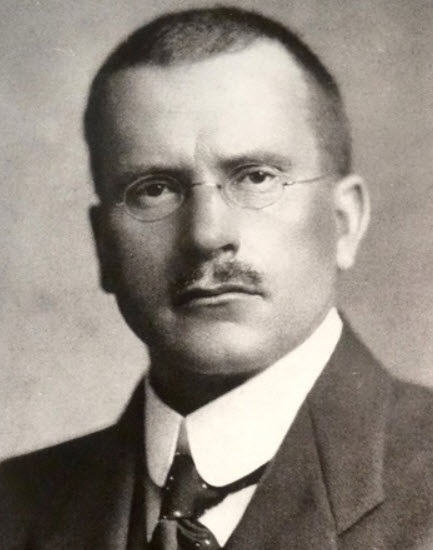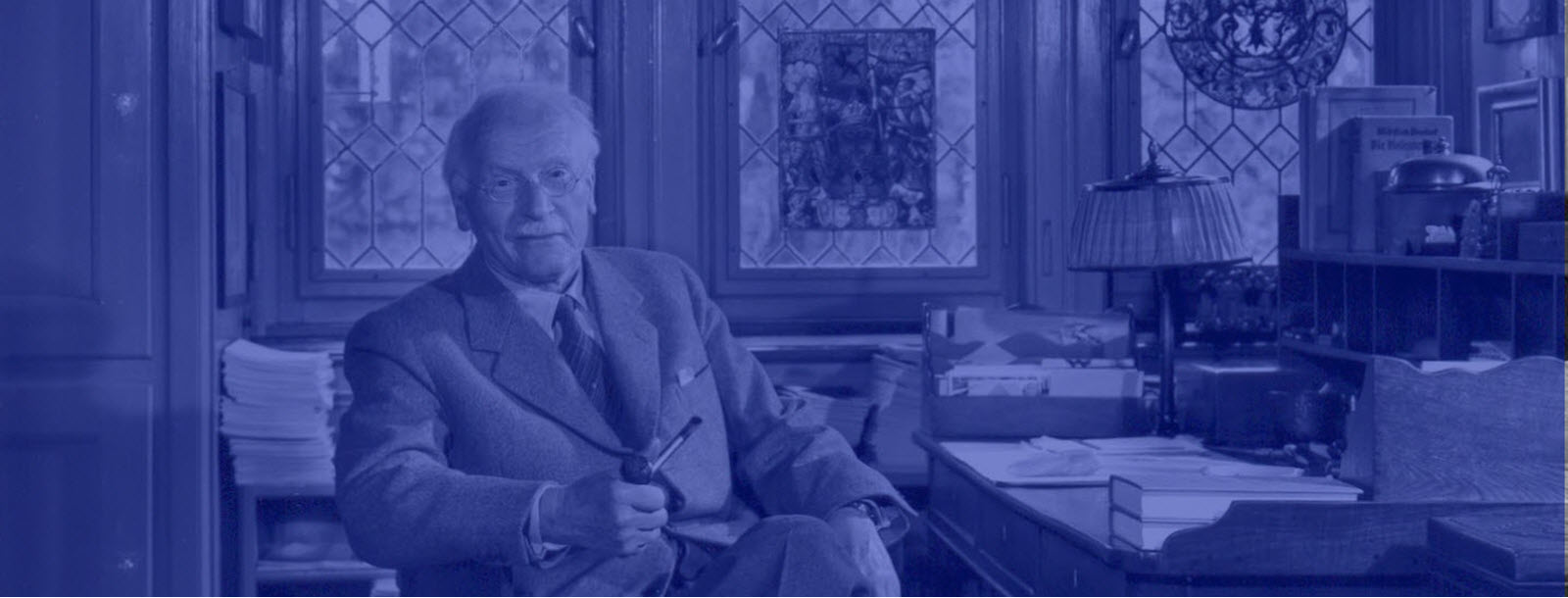Contents
Carl Gustav Jung (1875-1961) is the founder of analytical psychology. Born in Switzerland and educated at the University of Basil, the psychoanalyst Jung has been immensely influential in the fields psychology, psychiatry and anthropology.
 After earning his medical degree at university in Basel, Jung worked at the psychiatric hospital in Zürich, a university research hospital where he completed his doctoral thesis and – among other things – conducted research for his Word Association Experiment.
After earning his medical degree at university in Basel, Jung worked at the psychiatric hospital in Zürich, a university research hospital where he completed his doctoral thesis and – among other things – conducted research for his Word Association Experiment.
Jung’s research earned him worldwide recognition during his lifetime and numerous honours were bestowed on him, including honorary degrees from Clark University and Harvard University, and an appointment as a Fellow of the Royal Society of Medicine, England.
Examples of psychological concepts associated with Jung are archetypal phenomena, extraversion and introversion, the collective unconscious, psychological complexes, anima and animus, shadow, and synchronicity.
One of the central concepts of Jung’s analytical psychology is individuation, a lifelong process of psychological integration by which an individual is formed through differentiation of the self out of each individual’s conscious and unconscious elements. According to Jung, this was the main task of human development.
Jung was a prolific writer, but quite a few of his works were not published until after his death, and there are also texts that still remain unpublished.
Jung’s life was characteristic by strong curiosity and he made extensive research into subjects such as physics, sociology, anthropology, literature, and Eastern and Western philosophy, as well as more occult fields such as astrology and alchemy.
Short facts about C G Jung
- Name: Carl Gustav Jung
- Birth: In Kesswil, Thurgau, Switzerland on 26 July, 1875
- Death: In Küsnacht, Zürich, Switzerland on 6 June, 1961
- Alma mater: University of Basel (Universität Basel)
- Doctoral advisor: Eugen Bleuler
- Professional fields: psychology, analytical psychology, psychiatry, psychotherapy
Jung & Freud
While working as a research scientist under Eugen Bleuler at a psychiatric hospital in Zürich, Jung caught the attention of psychoanalysis founder Sigmund Freud, and the two commenced a correspondence that eventually led to several years of collaborations, and Jung’s appointment as the first president of the International Psychoanalytical Association.
A professional schism gradually built between Freud and Jung, and culminated after the 1912 publication of Jung’s book Psychology of the Unconscious. The two met for the last time at the Fourth International Psychoanalytical Congress in Munich in 1913, where Jung gave a talk on psychological types in analytical psychology. In many ways, this talk was an introduction to several key elements that would come to distinguish Jung’s work from Freud’s.
Examples of key concepts
Examples of key concepts of analytical psychology:
- AnimaA man’s inner personal feminine, conceived both as a complex and an archetypal image. According to Jung, the Anima is the contrasexual aspect of a man’s psyche.
- AnimusA woman’s inner personal masculine, conceived both as a complex and an archetypal image. According to Jung, the Animus is the contrasexual aspect of a woman’s psyche.
- ArchetypeUniversal and recurring mental images or themes, often found in mythology, religion and fairy tales. It’s a concept borrowed into analytical psychology from anthropology.In analytical psychology, archetypal images are universal symbols that can mediate opposites in the psyche.
- Collective unconsciousUnconsciousness experienced by all people regardless of culture.
- ComplexThe repressed organisation of images and experiences that govern an individual’s perception and behaviour. A complex is a core pattern of emotions, wishes, memories and perceptions seated in the personal unconscious, where the various aspects of the pattern are organised around a common theme.
- Extroversion and introversion Personality traits denoting degrees of openness or reserve.
- IndividuationAccording to Jung, individuation is a process through which the individual self develops out of an undifferentiated unconscious.
- ShadowRepressed aspects of an individual’s personality. Typically aspects are considered to be negative. The shadow represented the part of the personality that caused a person to become addicted to gambling, alcohol and other vices. Jung believed that only a genuine conversion could cause a person to break an addiction. This was often caused by hitting rock bottom and being forced to see the negative effects of your addiction.
- SelfThe psyche’s central archetype. It is a central overarching concept governing the individuation process.
- SynchronicityAccording to Jung, events are meaningful coincidences if they occur with no casual relationship yet seem to be meaningfully related. He called this concept synchronicity. During his career, he changed and adjusted his exact definition of synchronicity several times.
Bibliography
Below you can find examples of Carl Jung publications available in English.
Seminar notes
- Analytical Psychology (1925)
- Dream Analysis (1928-30), published in 1984
- Visions (1930-34)
- The Kundalini Yoga (1932)
- Nietzsche’s Zarathustra (1934-39)
- Children’s Dreams (1936-1940)
Books
- 1912 Psychology of the Unconscious
- 1921 Psychological Types
- 1933 Modern Man in Search of a Soul
- 1938 Psychology and Religion
- 1951 Aion: Researches into the Phenomenology of the Self
- 1952 Symbols of Transformation (revised edition of Psychology of the Unconscious)
- 1952 Synchronicity: An Acausal Connecting Principle
- 1954 Answer to Job
- 1955 Mysterium Coniunctionis: An Inquiry into the Separation and Synthesis of Psychic Opposites in Alchemy
- 1957 Animus and Anima
- 1961 Memories, Dreams, Reflections
- 1963 Analytical Psychology: Its Theory and Practice
Collected Works
The Collected Works of C.G. Jung is a book series containing the major writings of Jung, translated into English. Most of the texts were not written as books; they are essays, papers, lecture notes, letters, etc. Among other things, the book series contains revised versions of previously published works by Jung and new translations of some of his writings. The publication span texts written by Jung from 1902 until his death in 1961.
The source material has been edited and translated by Gerhard Adler and R.F.C Hull, occasionally with assistance from others. Several of the volumes contain extensive illustrations.
The Collected Works of C.G. Jung was published in the USA by Princeton University Press and in the United Kingdom by Routledge & Kegan Paul.
The Collected Works of C. G. Jung. Eds. Herbert Read, Michael Fordham, Gerhard Adler. Executive ed. W. McGuire. Trans R.F.C. Hull. London: Routledge Kegan Paul (1953-1980).
- Psychiatric Studies (1902–06)
- Experimental Researches (1904-10) (trans L. Stein and D. Riviere)
- Psychogenesis of Mental Disease (1907-14; 1919-58)
- Freud and Psychoanalysis (1906-14; 1916-30)
- Symbols of Transformation (1911-12; 1952)
- Psychological Types (1921)
- Two Essays on Analytical Psychology (1912-28)
- Structure and Dynamics of the Psyche (1916-52)
- Archetypes and the Collective Unconscious (1934-55)
- Aion: Researches into the Phenomenology of the Self (1951)
- Civilization in Transition (1918-1959)
- Psychology and Religion: West and East (1932-52)
- Psychology and Alchemy (1936-44)
- Alchemical Studies (1919-45):
- Mysterium Coniunctionis (1955–56):
- Spirit in Man, Art, and Literature (1929-1941)
- The Practice of Psychotherapy (1921-25)
- The Development of Personality (1910; 1925-43)
- The Symbolic Life: Miscellaneous Writings
- General Bibliography
- General Index
Supplementary volumes
- A. The Zofingia Lectures
- B. Psychology of the Unconscious (trans. Beatrice M. Hinckle)
Jungian psychology & financial theory
Jungian psychology has had a large impact on financial theory and it is beneficial to know a little about Jungian psychology f you want to understand financial theory. According to Jung modern politics have become a religion and that will cause the masses to act in a way that he refers to as collective insanity. This religification of politics is very damaging to society as some ideas get a religious following, and society will singlemindedly chase this goal regardless of whether it is rational to do so. A good example of this is that equality became a religion, and this “religion” led to communism. A religion” that thinks it is more important that everything is equal than that everyone gets more (a better life). This causes the total production to be lower than it would be if the main focus was to maximize the production and make sure that everyone gets more even if it is unevenly distributed.
This is just one example of what Jung referred to as collective insanity. It is easy to find more example of collective insanity by looking at the US financial markets. It is very easy to find examples of collective insanity if you look at the trading on the stock market. There are plenty of examples of bull and bear markets that are driven by collective insanity more than anything else. The US national debt spiral can also be seen as an example of Jungs collective insanity.
